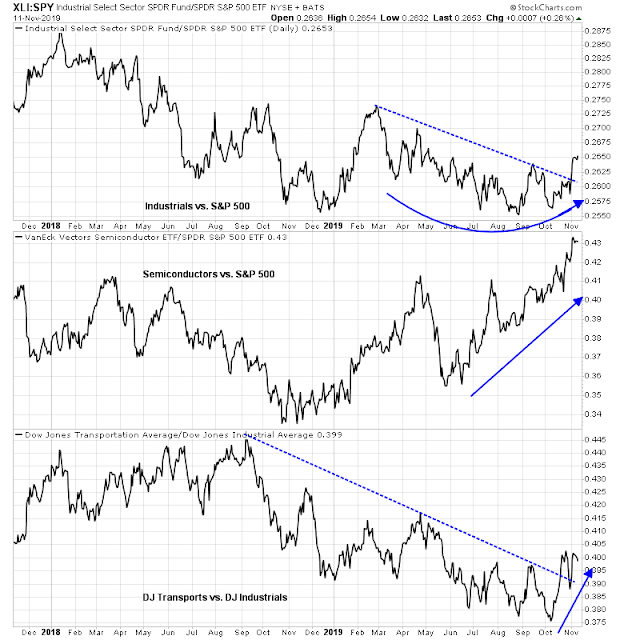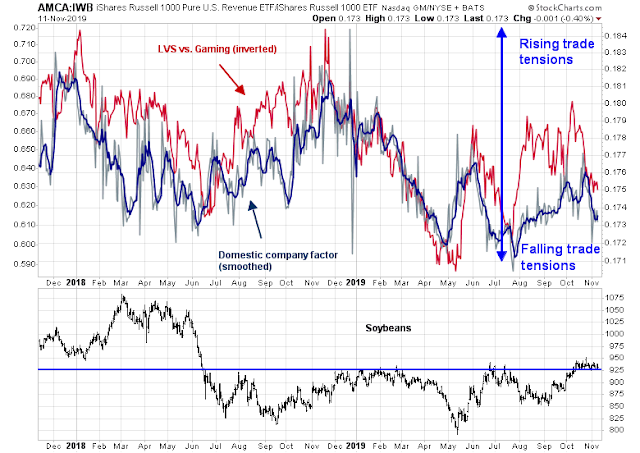Evidence is piling up that the economy is undergoing a cyclical recovery after a soft patch. The technical picture confirms the cyclical rebound narrative. The market relative performance of cyclical sectors and industries are all turning up. Semiconductors are now the market leaders, though they look a little extended short-term.
Here is the latest bottom-up update from The Transcript, which is a digest from earnings calls:
Succinct Summary: The US consumer is alive and well. The return of low rates has helped give the economy a boost, especially housing. It’s not a boom but an extension of the long bull market.
Macro Outlook:
The consumer is alive and well
“…strong demand environment that once again proved that the consumer, especially the North American consumer, is alive and well…The consumer is alive and well, and they are not afraid to spend money.” – Norwegian Cruise Line (NCLH) President & CEO Frank Del RioLabor markets are tight
“…the low unemployment rate and the numerous alternate employment opportunities makes the job of recruitment and retention more difficult than it has been in the past, limiting our ability to fully utilize our fleet and capture additional incremental market” – US Concrete (USCR) Chairman, CEO William J. SandbrookThere’s strong demand for medium-duty trucks
“A growing U.S. economy, coupled with high levels of consumer spending, low unemployment and low interest rates continues to drive demand for medium-duty trucks.” – Cummins (CMI) Chairman & CEO Thomas LinebargerThe US housing market is healthier than the overall economy
“…the US housing market…is now probably healthier than the economy overall.” – Redfin (RDFN) CEO Glenn KelmanThanks to low rates–It’s not a boom but an extension of the long bull run
“Overall low rates have strengthened home buying demand at least marginally over the course of the year…we may see broader price gains in the first half of 2020 and the return of bidding wars. It’s not a boom, but it extends the markets long Bull Run.” – Redfin (RDFN) CEO Glenn Kelman
Will there be a Phase One deal?
The key risk is the unraveling of the “Phase One” trade deal. We have seen this movie before. The market was given signals in May that US and Chinese negotiators were very close to a deal, then it all fell apart at the last minute.
Here is how Bloomberg’s outlined the risks:
The question on many people’s minds this Monday is whether that “substantial phase one deal” with China that President Donald Trump announced a month ago today is falling apart. There have certainly been enough conflicting signals coming out of the White House in recent days to make that a legitimate question. But the best answer to that may actually lie in the answers to another question: What happens if there isn’t a deal? So let’s consider that from the U.S. lens. There are consequences, you see.
- The first and biggest consequence would be a further escalation in the trade wars. Trump has already put an Oct. 15 tariff increase from 10% to 15% on one tranche of $110 billion in imports from China on hold. But there’s a bigger one looming in the Dec. 15 threat for new 15% import duties on a further $160 billion in goods including consumer favorites like smartphones and toys.
- If Trump didn’t go ahead with either of those threats he’d be exposing his own bluff, of course. Plenty of businesses would welcome it. So too would markets. And China. The only people who wouldn’t would be the hawks in his administration. But it would also be a blow to Trump’s longer term credibility in any negotiations with the Chinese.
- Of course, if he did go ahead with those tariffs that would leave almost all trade between the U.S. and China subject to new tariffs and the global economy would be preparing for what many economists believe would be a singular shock. U.S. consumers, who in recent months have started to encounter the costs of the trade war, would be suddenly confronting new choices and questions. “Alexa: Why is my new iPhone suddenly more expensive?”
- That would in turn likely hit business and consumer confidence going into an election year in which Trump is already facing impeachment and a slowing economy. Though the tariffs would technically begin to be collected before Christmas this year, the way supply chains work means the effect would take months to really filter through, so the second and third quarter of next year could see peak trade-war impact. Anyone for 1% growth — or worse — going into an already acrimonious presidential election?
My trade war factor is showing a high degree of complacency in the market. The red line measures the relative performance of Sheldon Adelson’s Las Vegas Sands (LVS), which holds major casino licenses in Macau that could be the target of Chinese political pressure should trade tensions rise. Soybean prices (bottom panel) is holding just above a key technical breakout level. All of these indicators point to expectations that a deal will be done.
Will there be a deal? The Chinese have demanded gradual rollbacks, not just suspension, of tariffs. Trump hasn’t made any decisions yet on what he will do.
We may see more clues when Trump addresses the Economic Club of New York at a luncheon tomorrow on November 12. Stay tuned.


Any thoughts, Cam?
You mean the Trump speech?
My reaction is,”Ho, hum”.
Yes, I agree that he didn’t say anything new, except that with markets up, he’s obviously more hawkish re China. You wrote: Are you still sanguine that Phase One will still happen and continue to drive the cyclical recovery narrative? Still buying the dip?
… not sure what happened.
Edit to the above sentence:
You wrote: The key risk is the unraveling of the “Phase One” trade deal. We have seen this movie before